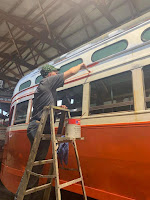It's time for another pictorial report of weekday happenings. I was out at the Museum last week, but didn't take any pictures, so there wasn't much to post. The important thing was that I was able to verify that the new motor bearing on the 309 seemed to work well, without overheating, so we're on track to get three more made to complete that truck.
And sitting in the shop is the old bearing. Note how thin it is. This will go into storage.
Memorial Day weekend is coming up, of course, and we plan to run the 309 and 319 on Sunday. So I put the train together, tested the brakes, and verified that everything was working properly. I only ran it back and forth a hundred feet or so, but that's enough.
It's kind of crowded out here. Not much room for good pictures.
If you can make it out to IRM on Sunday, stop by and say hello!
Lots of other projects were going on in Barn 4. Here's the latest new door for the 213:
John has been working on wiring up the 306, and here he is under the car pondering where all the wires are supposed to go.
Down in the pit, we get a good view of a traction motor.
And the wiring:
Frank Kehoe was helping on the 1808, stripping and refinishing interior woodwork.
He's also been a great help with the 309 bearings. And here is Tim painting the floor:
And I also spent some time collecting parts for a planned inter-museum parts swap, which we might bother to explain if it ever actually happens. Stay tuned!























































